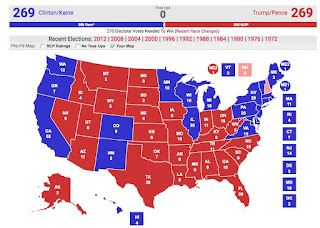But what about the approximately five percent of voters who voted for Johnson (~ 3%), Stein (~ 1%), and others (~ 1%)? What can we say about them?
The biggest question that is always asked is what would have happened if there was only two candidates on the ballot? Did the minor party candidates cost Clinton the election?
I think the CNN.com exit poll page has the most data of the major news sites. If you scroll all the way down, I think the screen capture of one of the items in the exit poll addresses that question.
This would suggest that if the 5% who went minor party, 63% would not vote on the POTUS if there were only two choices. Of the 37% who would make a choice, a slightly larger number would vote for Trump (21%) compared to Clinton (16%). Thus, the argument that Clinton was harmed by the presence of third party voters may not hold up. However, there is one big caveat: how was this question answered in specific swing states. Unfortunately, I don't have access to exit polling data of that specificity.
What else could be said about the minor party votes in 2016?
Demographically, younger voters (18 to 39) were two-times more likely to vote for a minor party. This demographic also supported Clinton while those 40 and older supported Trump.
We can speculate why this age divide occurred: perhaps some younger voters are less willing to accept the binary nature of presidential elections but as voters get older this changes.
Independents are also three times more likely to vote for a candidate from a minor party compared to those with a party identification. This is not surprising since they have opted out in terms of party registration. Trump won the independents 46% to 42%.
The 2016 voter totals for alternative party candidates was the highest since 1996 when Perot got 8% and the combined remaining other party candidates got almost 2%. Does this bode well for the future of alternatives to the Democratic and Republican parties? I suspect the high numbers reflects the historic unpopularity of the two main party candidates and not a trend toward greater support of third parties.
In the CNN exit poll charts, there were many variations on questions of the qualities of the candidates (temperament, qualified, honest, favorable/unfavorable). Of these, the one shown below was striking. Only 2% of voters surveyed viewed both candidates favorably. If the voter had a favorable view of the candidate, they inevitably voted for that candidate. Of the 18% that held unfavorable views of both candidates, more went to Trump (47% vs. 30%) and 23% of these voters opted to vote for a minor party candidate.
Finally, late deciding voters (within the final month) tended to go to Trump but a certain percentage decided to support minor party candidates.
In 2012, Johnson ran as Libertarian and Stein ran as Green and they combined to get 1.4% of the vote. In 2016, both improved on their 2012 numbers. However, one suspects that some of that increase is of a "protest" nature rather than outright support for them. Though there is an abstract desire for more options, even with historic levels of unpopularity for the two major candidates, 95% of voters still voted for one or the other.















